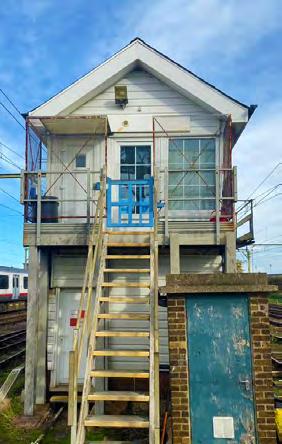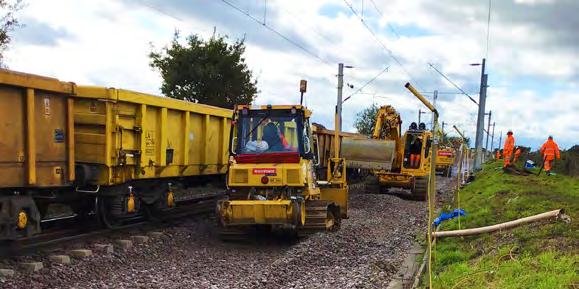
7 minute read
The power of collaboration
How a behavioural change is helping the major Clacton-on-Sea resignalling work continue through COVID-19
It was just over 12 months ago that Network Rail’s geographic regions took on accountability for the delivery of all projects within their borders, including track and signalling.
The move by the owner and infrastructure manager of most of the railway network in the UK was part of a drive to be more customer and passenger focused, allowing the regions to be better able to respond to local needs and demands.
“Clacton is another story that just shows that we can only deliver value for our customers if we all pull together,” said Boris Lucic, Network Rail’s Capital Delivery Director, Anglia.
“It is a story about integrating the supply chain, it is a story about integrating technology, it is a story about working closely with the industry partners to come up with the right logistics plan in terms of access and station operation that causes minimum disruption to passengers and users.
“As we are getting through the crisis of COVID-19, it is that mentality of together we stand, divided we fall that is more critical than ever to our joint industry success. We are sharing best practice, learning from each other and working together to deliver value for the customer. The Clacton story is the proof that devolution has happened here in Anglia.”
It is a view shared by Charles Newlands, Director of Signalling and Telecoms Operations at Atkins, a top 10 supplier to Network Rail. “We have embarked on an ambitious transformation in relationships and behaviours since the devolved regions came into play.
“The badges are off and there is a real sense of teamwork with an overwhelming desire to achieve common programme dates. Everyone is digging deep to find a new way of working so we can keep the infrastructure running through some very challenging times.”

£37 million system
As Principal Contractor, the Atkins team has been working with Network Rail on the new £37 million signalling system in the Clacton-on-Sea area to replace the Victorian equipment with modern technology.
The project will upgrade a mix of semaphore and 1950s colour-light signals equipment to modern standards, controlled centrally from the existing Alstom Modular Control System at Colchester Powered Signal Box.
The team has risen to the challenges surrounding COVID-19, delivering every project milestone, with the successful installation of 13 new OLE structures, two new relocatable equipment buildings, a new power supply, six new signal foundations and over 25,000m of new cables during the recent preparatory works. “It isn’t different in terms of the general principles of how a project is done; but what is different is how it is done in terms of behaviours and dialogue that has taken place between all the industry partners,” said Boris, who has worked in the industry for over 20 years.
“It is more a behavioural change. The drivers are always the same, these jobs are always about integrating technology and they’re about logistics which ultimately means that they are about people and industry partners working together. Unless you have that team of all parties involved, then you really will struggle to navigate these waters.”
As it stands, everything is on track ready for the major February works, something Gary Green, Network Rail’s Senior Programme Manager in Capital Delivery Anglia, says is largely down to this behavioural change.
“There has been a desire for us to change from previous projects, and despite plenty of challenges we’ve worked collectively to overcome them,” he said.
“Timescales were very tight on this project and needed a different type of collaboration. The team has really set about having a joint approach of making sure that, when we find problems, we work collectively and quickly agree the solution and move forward.
“Rather than a commercial battle, an ongoing debate, it was a forum that we would use to look at issues and tackle them together and come up with the best solution.
“That has been the real change with this project. We’ve got a really good process in place commercially for early warnings and progressive assurance for engineering. It is that kind of approach really that has so far meant that we’ve been able to keep this project on track towards its commissioning date.” It is a change which has been welcomed across the board, as Marco Lombardelli, from Global Rail Construction Ltd, confirms. The company is a sub-contractor delivering the D&C civils/ structural requirements on the Clacton project on behalf of Atkins.
“Excellent planning, collaboration and the ‘one team approach’ has ensured that works were delivered safely, successfully and without serious issue, even with the impacts of COVID-19,” he said. “Very early in the pre-construction phase of the project, Network Rail, Atkins and ourselves held regular, weekly telecoms to identify the risks and to discuss control measures, mitigation and additional support, aiming to deliver a safe working environment for everyone.
“It has been an excellent project to be involved with, mainly due to the close working and good communication by all parties involved. Importantly, our teams feel part of this project and they feel they have contributed in a major and inclusive way.” (See page 23 for more information)
Collaborative working
John O’Boyle, Managing Director of OSL Rail, the multidisciplinary signalling contractor for the delivery of the Clacton resignalling works, said: “OSL began work with Atkins and Network Rail on the Clacton project in June 2020 at the height of the coronavirus pandemic.
“The government guidance and rules were changing by the day and our main challenge was to ensure all parties on site were kept safe.

The uncertainty also had the potential to affect our supply chain, but by collaboratively working together the Clacton resignalling project remains safe, efficient and ahead of schedule. “The one-team approach on this project has increased efficiency, removed the possibility of conflict and has ensured that every milestone is achieved safely. It is a great example of what trust and collaboration can deliver.”
Whilst Network Rail is upgrading the signals and track, Greater Anglia is introducing brand new trains as part of the plan to improve rail journeys for passengers.
Tony Gordon, Infrastructure Delivery Director at Abellio, owning group of Greater Anglia, which runs the railway in Clacton, said: “It is working really well generally. What might seem on the surface to be quite minor issues are being escalated relatively quickly to someone within each of the organisations to get them resolved.
“There are also regular board meetings, so we are all getting answers quickly. As an industry, things had to change and that is happening. As Charles has pointed out, it is really important that we get better at delivering projects more efficiently. “We need to be more efficient to keep the levels of delivery up and the only way to do that is collaboration. Everyone has bought into that and are more willing to be flexible and agile in our approaches.”

Across weekends in September and October, the teams completed the preparatory works ahead of the intensive works in February and March.
“Because of COVID-19, we could have quite easily said everything has to stop, we just have to wait six months,” said Charles. “But what we’ve done is said ‘No, we will put Clacton at the top of our agenda. It is being delivered within budgets and timeframes to ensure Clacton will be safely delivered on time. This is all down to this behaviour change and collaboration.
“The Atkins model has supply chain embedded within our team and stripped out layers of man marking. The use of smart technology like ‘iAuditor’ is a real game changer, building a transparent, progressive assurance and trust at all levels within the project.”
It is a view agreed with by Boris, who finished by saying: “Clacton is a good example of being creative and looking at different ways of working to outwit the virus and be able to continue with the work safely. We haven’t missed a single milestone on Clacton, and if you go to the sites this has been done whilst maintaining very good, safe working practice. I think Clacton is a testament to that creativity and that ability that if we come together, use all of our brain power, good behaviours and good leadership on site we can keep moving with these vital projects and deliver for customers, even during COVID-19, and build back the economy.”










